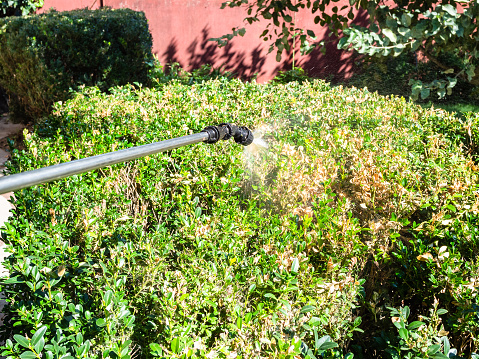Various fungi that cause boxwood diseases have been isolated and characterized. These fungi include Neofusicoccum buxi, Neofusicoctria foliicola, and Pseudonectria buxi. These fungi were cultured, inoculated, and tested on the leaves of boxwood. After seven to 21 days of incubation, symptoms were noted on infected leaves. The mock-inoculated controls did not display any symptoms.
Volutella blight
Volutella blight is an infection caused by a fungus that enters boxwoods through cracks on branching junctions. The fungus can disfigure the plants and prevent them from growing properly. The infected leaves become bronze or red and remain attached to the branch or the tree until they die. The infected leaves may also have pinkish fruiting structures on the lower surface. While Volutella blight does not kill boxwood, it can severely defoliate the plant during the summer months.
Volutella blight can be controlled using a fungicide. The fungicide should be applied after removing dead plant tissue. If the fungicide does not kill infected twigs and leaves, it will not be effective. Several fungicides, such as thiphanate-methyl or copper-based products, are available. It is important to wear protective clothing and follow label instructions when applying a fungicide to a tree.
The fungi that cause Volutella blight on boxwood are Coccinonectria pachysandricola and Coccinonectria buxi. These fungi have also undergone a variety of other names, including P. foliicola and C. pachysandricola. The fungi that cause Volutellia blight have undergone many names since their discovery in 1815.
In 2011 a new boxwood pathogen was discovered in the U.S. and many people believed that this meant the end of boxwood in landscapes. However, recent research studies have shown that this prognosis was premature. A number of methods for managing boxwood blight have been devised, including sending sample trees to diagnostic labs and replanting with less susceptible varieties. fungicidal treatments are also available for non-infected plants.
Volutella blight is primarily caused by a fungus called Volutella pachysandricola, which lives on infected plants and pachysandra plant debris. The fungus produces masses of light-orange to pink spores, which are visible to the naked eye.
Macrophoma leaf spot
Boxwood dieback symptoms are caused by an infection of Macrophoma leaf spot, a fungal disease that affects the leaves of the plant. Infected leaves do not shed, but remain attached to the branches. These symptoms are different from those caused by Volutella blight, which is another fungal disease. Boxwood dieback is characterized by a bright black discoloration of the stem under the bark that extends along the infected twigs.
The two most common diseases of boxwood are Volutella blight and Macrophoma leaf spot. The exact taxonomy of both fungi is unknown, but they are related to the decay of dead leaves beneath shrubs. While they can be difficult to detect in a boxwood landscape, they should be treated as soon as they appear.
The most common susceptible varieties are American and English boxwood, but other species and hybrids are also susceptible to the disease. To prevent infection, nurseries should select cultivars with low susceptibility to this disease. In one study, common and English boxwoods had the most severe effects. However, Korean boxwood and ‘Winter Gem’ boxwood exhibited the least disease impact.
Macrophoma leaf spot in boxwood is caused by the fungus Macrophoma candollei. This fungus attacks the leaf and root systems of boxwood. This fungus causes red-brown lesions on the leaves and produces black fruiting bodies on the undersides of the leaves.
This fungus is similar to Neofusicoccum foliicola. It is a fungus that can grow in temperatures ranging from 50 to 95degF. It is most prevalent when temperatures are in the 68-77 degree range, however, it is also susceptible to cold and very hot temperatures. The fungus needs a wound to invade the boxwood leaf and grow.
Phytopthora root and crown rot
Boxwoods and other ornamental trees can become susceptible to Phytopthora root and crown rotting. The disease is caused by soilborne pathogens that cause death of the inner bark of the tree. It also causes browning of the sapwood. The disease typically affects young trees with small root systems.
Phytopthora root and crown rotting is caused by several species of Oomycetes, or water molds. Symptoms of this disease can include rotting wood, decaying bark, and weakened branches. It is important to recognize the symptoms of this disease so that control methods can be developed.
The pathogen can survive in soil for years, and is spread to other plants through splashing water and runoff water. It can also spread through contaminated soil and garden equipment. It thrives in soil that is wet and warm. It can also cause dieback and stem blight in boxwood.
Fungicides are an effective way to control the disease. Fungicides such as Empress Intrinsic and Subdue Maxx can be applied to boxwood cuttings. In trials involving field-grown boxwood, fungicides were found to be effective at reducing the severity of root rot. Fungicides can be applied as a spray or as a drench to the soil.
The fungus, Phytopthora, feeds on the roots of boxwoods. It affects the root system of boxwoods and can kill the entire plant. Therefore, it is important to keep boxwoods pruned and protected at all times.
If you suspect boxwood dieback, the best method for diagnosis is to send the plant for evaluation to a diagnostic clinic. It is important to send the entire plant for evaluation, as just sending dead twigs will not generate a reliable diagnosis. Symptomatic twigs should be wrapped in dry paper towels and placed in plastic ziplock bags and sent to the state plant diagnostic laboratory. Make sure you receive approval from the state plant diagnostic laboratory before sending samples.
Phytophthora
Phytophthora boxwoodiis is an invasive fungus, which is often caused by a plant that is susceptible to the disease. The host plant for this fungus is the boxwood (Buxus spp.), which has a pH ranging from 6.8 to 7.5. If you are considering planting boxwood in your garden, you need to know the symptoms and treatment methods.
This fungal pathogen infects plants by growing on the stems and leaf petioles. Once infected, spores wash down the stems and reach the roots. Infected plants will require the application of a preventative fungicide or treatment with a fungicide.
Symptoms of boxwood dieback include browning, yellowing, and wilting foliage. Some plants may also exhibit symptoms of root rot and crown rot. The leaves will also turn upward and develop discolorations near the soil line. If you notice these symptoms, you must isolate the infected plant from the healthy ones.
If you suspect your boxwood plant is infected with Phytophthora boxwoodi, it is best to submit a plant sample to a plant diagnostic lab. A plant diagnostic lab can properly identify the disease and offer effective treatment. If you suspect your plant has been infected, it is recommended to contact a local university plant diagnostic lab.
In a recent trial, researchers from the Tennessee State University Ornamental Pathology Program evaluated fungicides as a preventative and control method for Phytophthora boxwoodi. The results showed that fungicides used alone and in a rotation program significantly reduced the severity of Phytophthora boxwoodi root rot. In addition, fungicides also improved plant height and total fresh weight compared to non-treated boxes.
Boxwood leafminers are one of the most common insect pests of boxwood. This small insect is less than an eighth of an inch long and feeds on the tissue of boxwood leaves. It has one generation a year, so it’s important to prevent infestations. Fortunately, the pest can be prevented by choosing genetically resistant cultivars.



